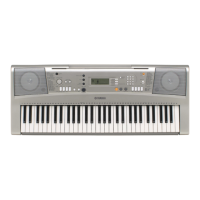
Do you have a question about the Yamaha Portatone YPT-300 and is the answer not in the manual?
| Type | Portable Keyboard |
|---|---|
| Keyboard | 61 keys |
| Songs | 102 preset songs |
| Display | LCD |
| Speakers | 2 x 2.5W |
| Polyphony | 32 notes |
| Effects | Reverb, Chorus |
| Power Supply | PA-3C/PA-130 or 6 x AA batteries |
| Connectivity | Headphones |
| Weight | 4.9 kg |
Information is believed correct at time of printing, but Yamaha reserves the right to change specs.
Product may produce sound levels causing permanent hearing loss. Avoid high volumes.
Covers service charges, environmental issues, battery, disposal, and name plate location.
Modifications not approved by Yamaha may void FCC authority.
Use only high quality shielded cables and follow installation instructions.
Product tested for FCC Part 15 Class B. May cause interference if not used correctly.
Product incorporates software and content with copyright belonging to Yamaha or third parties.
Lists trademarks like Windows.
Explains GM Level 1 system, XGlite, and stereo sampled piano.
Highlights learning tools and touch sensitivity feature.
Lists included accessories: music rest and manual.
Explains using AC adaptor or batteries for power.
Instructions and precautions for installing and using batteries.
How to connect headphones, footswitch, and MIDI terminals.
How to connect the AC adaptor and turn the instrument on/off.
Overview of buttons and controls on the front panel.
Details on connections available on the rear panel.
How to select and play various instrumental voices.
Step-by-step guide to choosing a voice using number buttons.
Procedure to choose a specific dual voice.
Guide to selecting a specific voice for the left-hand split.
How to select the Grand Piano voice with a single button.
How to select drum kits and percussion sounds.
How to activate and play the sound effect kit.
How to turn the metronome on and off.
Guide to setting the tempo using number and +/- buttons.
How to set the time signature for the metronome.
How to adjust the volume level of the metronome.
How to select and play built-in songs.
Steps to start and stop song playback.
Controls for rewinding, fast-forwarding, and pausing songs.
How to play demo songs.
How to choose and play different musical styles.
Steps to start and stop style playback.
How to use auto accompaniment with bass and chord accompaniment.
How to start playback by touching a key.
How to play chords to control style playback.
How to stop the style playback.
How to record up to five user songs.
Steps to begin recording a performance.
How to stop recording and save the performance.
How to record to Track 1 or Track 2.
Step-by-step guide to deleting recorded user songs.
How to save instrument settings to internal flash memory.
Procedures for clearing backup data or performing instant clear.
How to connect power and control the master volume.
Explanation of START/STOP button and hold symbol.
How to select SONG, STYLE, or VOICE modes.
Using number buttons and +/- for input.
Introduction to the FUNCTION button and its 32 settings.
Explains notation, track, time, chord, and keyboard displays.
Overview of the lesson process and three practice methods.
Focuses on listening and learning the melody.
Explains the grading system based on timing accuracy.
How to change the melody voice of a song.
How to balance song playback volume with keyboard playing.
How to add harmonic notes to the main voice.
How to add the ambiance of a room or concert hall.
How to choose from different reverb types.
How to add richness and spaciousness to the sound.
How to add fixed sustain to keyboard voices.
How touch response works and its benefits.
Steps to adjust the keyboard's sensitivity to playing dynamics.
How to change the split point for different left/right hand voices.
How to shift the overall pitch up or down.
How to precisely adjust the instrument's pitch.
Automatically selects the most suitable voice for a song or style.
How to adjust the tempo for songs and styles.
Details on adjusting volume, octave, and chorus send for voices.
Explains three methods: Instant, Chord, and Tap Start.
Simple methods for playing chords using few fingers.
Playing chords with standard fingerings for accompaniment.
Lists common chord types recognized by the instrument.
How to navigate and adjust the 32 available function settings.
How to save current settings to flash memory.
Explanation of MIDI and its role in musical communication.
Overview of how MIDI can be used with the instrument.
How to transfer performance data between instruments via MIDI.
Explanation of MIDI settings and the Local Control function.
Using the keyboard as a remote control and transmitting panel settings.
How to transfer songs and user data to/from a computer.
Guide to downloading and installing the Musicsoft Downloader application.
Steps for connecting the keyboard to a computer using a USB-MIDI interface.
How to transfer songs and user files from a computer to the keyboard.
How to select tracks for lessons with transferred songs.
Lists common issues and their remedies, e.g., no sound, noise, or incorrect playback.
Details the instrument's maximum polyphony of 32 notes.
Explains drum kit notations and provides a comprehensive list of drum kits.
Lists all available styles categorized by genre.
Details the 26 harmony types and their sonic characteristics.
Lists the 10 reverb types and their sonic characteristics.
Lists the 5 chorus types and their sonic characteristics.
Details MIDI messages the instrument transmits and recognizes.
Further breakdown of MIDI messages, including System Exclusive and Aux messages.
Explains MIDI data formats and System Exclusive messages.
Shows how effect types correspond to LSB values for Reverb and Chorus.
Details the keyboard, display, and setup features.
Covers voice polyphony, types, and style features.
Details function, effects, recording, and MIDI specifications.
Lists power requirements, dimensions, weight, and accessories.
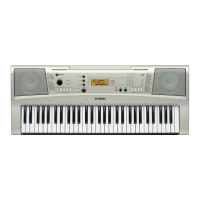

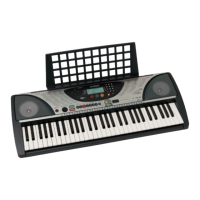
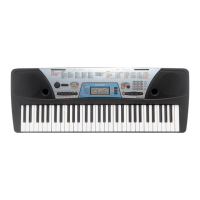
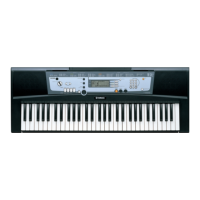
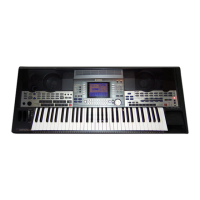


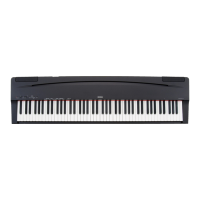
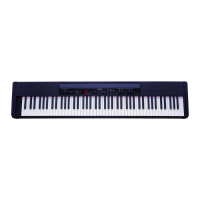
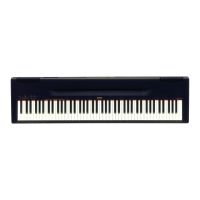
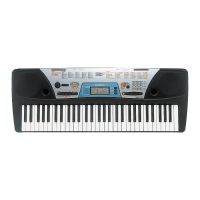
